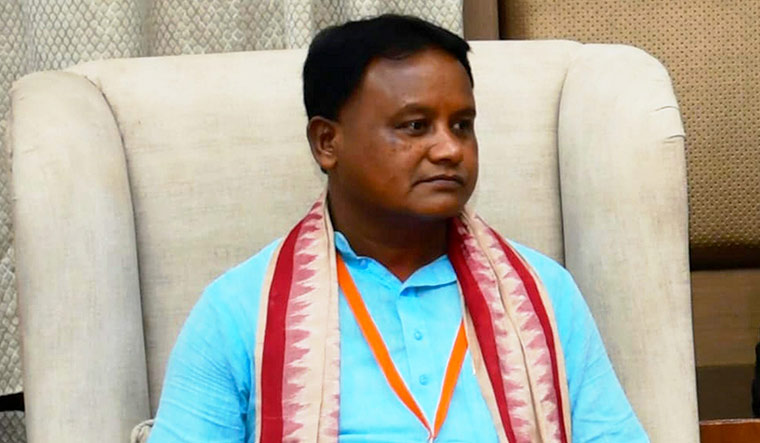Caste does not matter much in Odisha politics. But it seems the BJP is up to experimenting with it, as it chose a tribal face as its first chief minister in the state over more familiar names―Mohan Charan Majhi, a four-time legislator from Keonjhar district, who belongs to the Santhal tribe, like the president of India, Droupadi Murmu. Tribals constitute almost a quarter of the state’s population. Majhi, 52, is the third tribal chief minister in the state―Congressmen Hemananda Biswal and Giridhar Gamang had short tenures in the 1990s.
A law graduate, Majhi started his career as a school teacher in Saraswati Shishu Mandir in Jhumpura and had an inclination to the RSS ideology since his student days. He started his political career as a sarpanch, and was first elected to the assembly from Keonjhar in 2000. He is close to Union Minister Dharmendra Pradhan, who is said to have played an important role in his elevation to the top post.
In an attempt to get the caste and regional equations right, senior leader Kanak Vardhan Singh Deo and first-time legislator Pravati Parida have been made deputy chief ministers. Singh Deo, a six-time legislator, is the scion of the Bolangir royal family. His grandfather R.N. Singh Deo was Odisha’s first non-Congress chief minister, and his wife, Sangeeta Kumari, has been reelected from the Bolangir Lok Sabha constituency.
While Majhi is from north Odisha, Singh Deo is from the western part of the state and Parida is from the coastal area. Naveen Patnaik, who ruled Odisha for 24 long years, suffered his first defeat in his political career in the Kantabanji constituency in Bolangir, Singh Deo’s home turf. The BJP’s Laxman Bag beat the Biju Janata Dal chief by around 16,000 votes in Kantabanji. Patnaik, who had contested from Hinjili also, won there.
The BJD’s unexpected defeat marks a turning point in Odisha’s political history. Patnaik, 77, who started as a reluctant politician, turned Odisha into one of the best-governed states in the country. Though he rarely spoke their language, generations of Odias showered him with their affection and votes. He was just about two months away from becoming the longest serving chief minister in the country.
The results meant that Odias this time favoured the double engine promise of Prime Minister Narendra Modi over the ‘double sankha’ (party symbol conch) slogan of the BJD. During the campaign Modi had launched a frontal attack on his “old friend” Patnaik, questioning his ability to rule the state owing to his deteriorating health and the influence of bureaucrats. The BJP singled out V.K. Pandian, a 2000-batch IAS officer from Tamil Nadu, who left the services and joined the BJD. As Patnaik was confined to Bhubaneswar, Pandian travelled across the state to hard-sell the government’s welfare schemes. He became the face of the party’s campaign and was believed to be Patnaik’s political successor.
The BJP turned the heat on Pandian, calling him an outsider; he is a Tamil. It brought in heavy fire power as its central leaders campaigned in the state forcing Patnaik to respond to the criticism, thus losing control over the narrative.
The BJD’s loss is the BJP’s gain, as the 20 Lok Sabha seats it won from the state have offset some of its losses in the other eastern states of Bihar and West Bengal. And the loss might be stinging for Patnaik as he had helped the Modi government pass key laws, and his closeness to the BJP provided it an easy entry to the state and allowed it to gain foothold.
―With Pratul Sharma.


